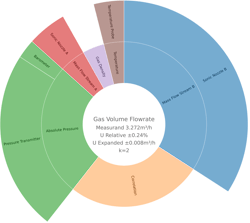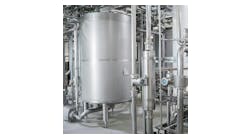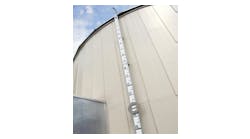The growing importance of live uncertainty calculations to help achieve accurate measurement
Measurement is a fundamental aspect of many processes across a wide range of industries. However, all measurements are approximations and lie on either side of an elusive “true” value. Therefore, no measurement is completely perfect and will always carry some degree of doubt, known as the measurement uncertainty. It is important to be able to quantify uncertainty as it may be critical for a given process and can have a direct impact on compliance with regulatory rules and revenue.
In most processes, there are usually several different measurements that combine to achieve a final output. A good example is an oil pipeline where one or several flowmeters are used to measure the quantity of oil passing through the pipe. As oil is a valuable commodity, the financial allocation from the sale of the oil is ultimately dependent on the uncertainty of the flow measurement.
However, flow is a derived quantity and depends on several different measurements including mass, time, temperature, pressure and fluid properties, among others. Each of these different quantities has its own associated uncertainty, and the sensitivity of each input to the output flow rate will vary. Therefore, to determine the uncertainty of a derived quantity such as flow, each sub uncertainty needs to be combined using statistical standards to create an “uncertainty budget.” Once an uncertainty budget has been created, it can be used to analyze the uncertainty for a given set of conditions. Much like a financial budget, it allows for the understanding of input sensitivities and provides effective financial control for measurement.
Traditional methods
It is common for an uncertainty analysis to be performed offline after data has been collected, and, in many cases, data is processed through a budget for a limited number of operating conditions (library values), to try to effectively cover the operating envelope of a given process. This then provides a range of uncertainties that can be used for reporting. Depending on the application, this "static" uncertainty analysis can suffice if the process is relatively simple or stable.
However, this method comes with several downsides. It can often result in conservative uncertainty values, as it does not utilize live data and therefore may overestimate the uncertainty. It can lead users to always report the “worst-case” uncertainty and may paint a false picture of inaccuracy. There is often a disconnect between live data capture and uncertainty analysis, with separate offline processing of uncertainty common practice. This can lead to time delays and additional costs, especially if process conditions are continually changing. Furthermore, large uncertainties or problems with instrumentation may not be discovered until long after a test or operation is complete. These problems can be eliminated by adopting live or real-time uncertainty analysis.
The benefits of live uncertainty
Adopting a system providing live or real-time uncertainty that reflects actual operating conditions can result in significant benefits. One way of achieving this is to interface an uncertainty budget with a supervisory control and data acquisition (SCADA) system, where measurements are continually updating. The budget can then use live data to perform uncertainty calculations. By linking an uncertainty budget to live data capture, it can immediately highlight problems with a particular process or instrument. For example, if an instrument is unstable or reading erroneously during data collection, this would result in a larger uncertainty than normally expected. Using a static offline budget, problems such as this may not be identified until long after data has been collected and processed, and by that point, it may be too late to rectify any issues. With live uncertainty, the test operator or user is immediately informed and can take steps to troubleshoot, providing an invaluable diagnostic tool.
Live uncertainty systems can also be tied to an instrument library for more accurate analysis. It is common for an uncertainty budget to use nominal values for a single type of instrument, for example, one uncertainty for all temperature instrumentation within a given process. However, in practice, each individual instrument will vary in its calibration route, drift over time and overall performance, ultimately leading to a variation in uncertainty. By linking an uncertainty budget to an instrument library, users can define instrument-specific uncertainties, which can be pulled in dynamically during a live uncertainty analysis. This can facilitate more accurate uncertainty reporting and assist with the traceability of uncertainty budgets.
An emerging trend
Live uncertainty analysis is appearing in several sectors, and it can be an important tool for minimizing financial losses. Recently, TÜV SÜD National Engineering Laboratory helped a major European pipeline operator to investigate instruments employed in their bunkering transfer from oil tankers to shore-based tank farms and onward through their network of pipelines. The measurement systems were surveyed and incorporated into an uncertainty budget. This budget was then incorporated into the live data feed from transfer operations, which immediately showed the operators if the tanker’s bill of lading was outside acceptance limits while the ship was still docked. In one transaction, the calculation verification uncovered a discrepancy of $16,000.
Within testing and calibration, TÜV SÜD National Engineering Laboratory has recently implemented a live uncertainty system for the UK National Standard flow facilities. With this new system, uncertainty data is presented to test operators and users of the flow facilities immediately after data collection. It works in tandem with TÜV SÜD National Engineering Laboratory's data acquisition software, using live data captured from the facilities to calculate uncertainty, rather than estimated or library values. It is also linked to TÜV SÜD National Engineering Laboratory's instrumentation library for more accurate uncertainty analysis. The disconnect between live data capture and uncertainty analysis has therefore been removed, providing numerous benefits, and supporting ongoing efforts to reduce measurement uncertainty. This live uncertainty system has also been coupled with powerful data visualization to further enhance TÜV SÜD National Engineering Laboratory's uncertainty toolkit.
Data visualization, lifting the veil
One common complaint surrounding uncertainty, and specifically uncertainty budgets, is that they are difficult to understand or interpret. Uncertainty is often regarded as a dark art — only fully understood by a chosen few. These complaints are not without merit, but can often lead to uncertainty being overlooked or, in some cases, ignored. To address these concerns, live uncertainty can also be coupled with data visualization to provide a powerful toolkit for presenting and interpreting uncertainty data. Rather than a flat table of data or an overly complex uncertainty budget, results can be presented in the form of fully interactive reports, including sunburst or hierarchal tree charts (see Figure 2). These interactive charts allow the user to click and navigate through the different levels of an uncertainty budget with relative ease, quickly identifying the various components that make up an uncertainty budget.
Data visualization is particularly useful when troubleshooting areas of high uncertainty. Not all measurements will contribute equally to an uncertainty result; some components may be insignificant where others may dominate. Determining which areas to focus on can be a challenge. Visual charts and tools can help quickly identify areas where money should be spent to improve measurement capability.
Visual charts and tools are also extremely useful in communicating uncertainty data to those inexperienced in the statistical methods required to create an uncertainty budget. Democratizing uncertainty via effective data visualization can therefore highlight its importance to all users involved in a process, which is a vital step in improving measurement capability. If more users are aware of the importance of uncertainty and where each source comes from, it becomes easier to identify areas for improvement, ultimately driving advances in measurement capability.
Adopting live uncertainty reflects real-world conditions and can empower decision-making. Oil, gas and chemical industries are showing a growing interest in real-time uncertainty analysis to help achieve more accurate measurement, including flow and energy balances. Combined with effective data visualization, it becomes a powerful tool. Those who adopt live uncertainty will ultimately reap the rewards, including minimizing financial losses, enhanced diagnostic data and easier targeting of measurement improvements.
Tariq Boussouara is a project engineer at TÜV SÜD National Engineering Laboratory, a world-class provider of technical consultancy, research, testing and program management services. Part of the TÜV SÜD Group, it is also a global center of excellence for flow measurement and fluid flow systems and is the UK’s Designated Institute for Flow Measurement.

Tariq Boussouara | Project Engineer at TÜV SÜD National Engineering Laboratory
Tariq Boussouara, Project Engineer at TÜV SÜD National Engineering Laboratory, a world-class provider of technical consultancy, research, testing and program management services. Part of the TÜV SÜD Group, it is also a global centre of excellence for flow measurement and fluid flow systems and is the UK’s Designated Institute for Flow Measurement.



